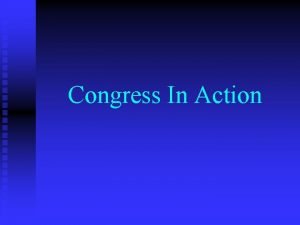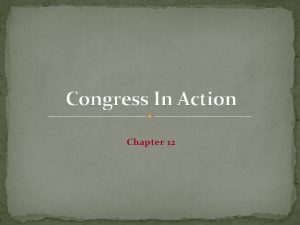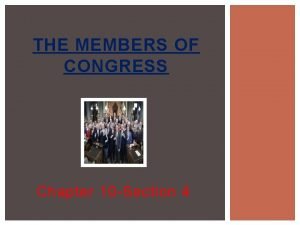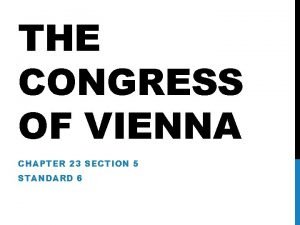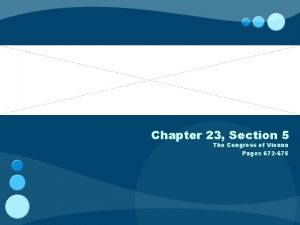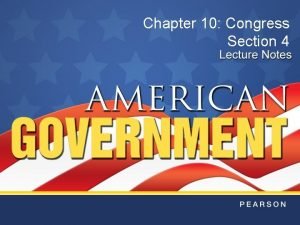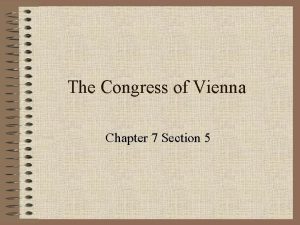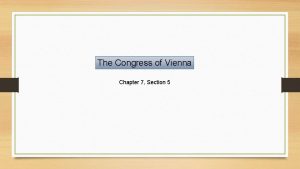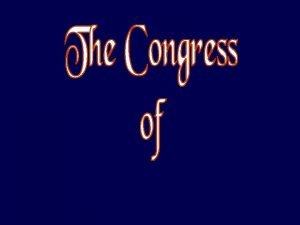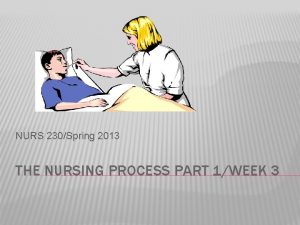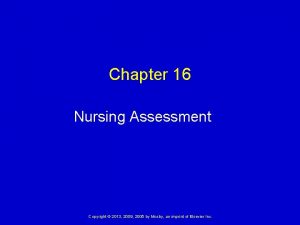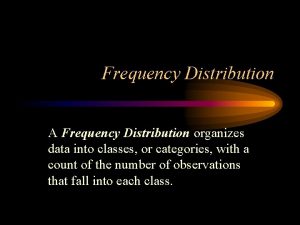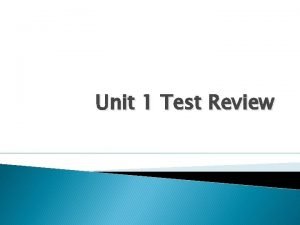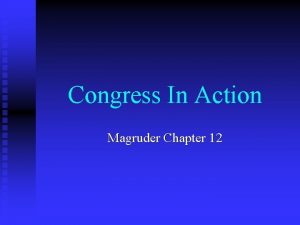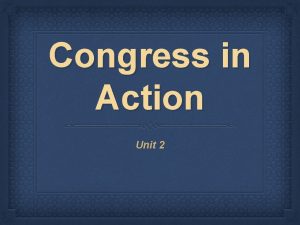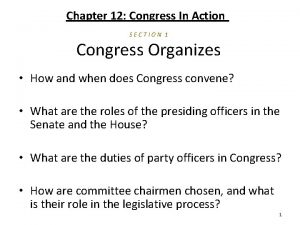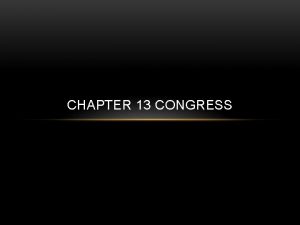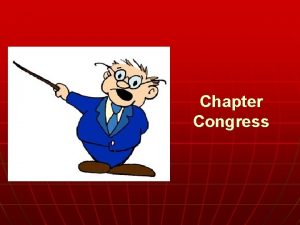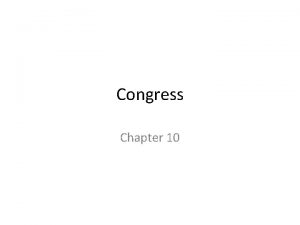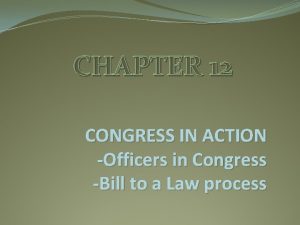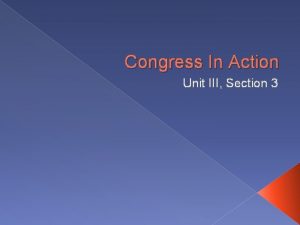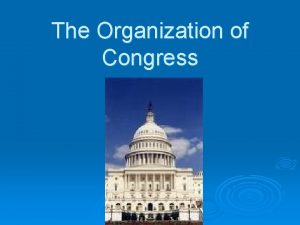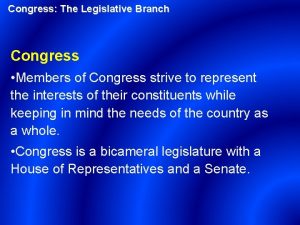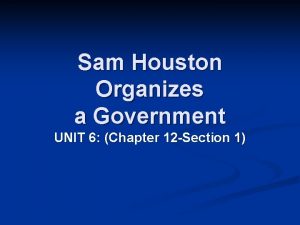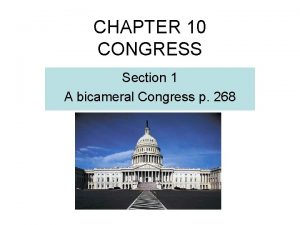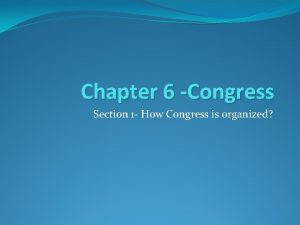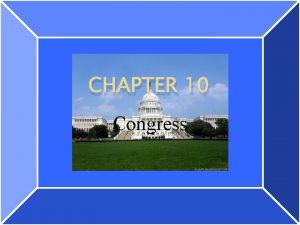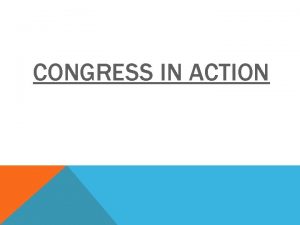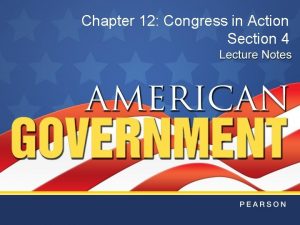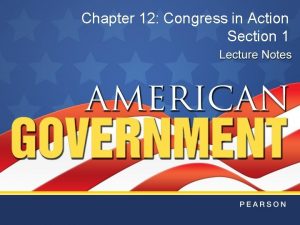Congress In Action Chapter 12 Congress Organizes Section






















- Slides: 22

Congress In Action Chapter 12

Congress Organizes Section One

Every 2 years when Congress starts a new term, the House reorganizes because new members are taking seats. The members elect their leader, who swears in all the members. They then adopt their work rules and appoint the members of their permanent committees. The Senate does not need to reorganize because two-thirds of its members stay the same from term to

Presiding over the House is the Speaker of the House, who may debate or vote on any matter before the House. The Speaker is the majority party's leader and the most powerful person in Congress. Speaker of the House, Paul Ryan (R), Wisconsin

House Chamber

The Vice President of the United States acts as president of the Senate. The Vice President oversees the Senate's sessions but cannot debate and votes only in a tie. In the Vice President's absence, the president pro tempore presides. Vice President Mike Pence

Senate Floor

Next to the Speaker, Congress's most powerful leaders are the majority and minority party leaders. They are chosen by the party to be its chief spokesperson. The main job of the party leaders is to get their party’s bills passed. They are aided by whips, or assistant party leaders. The whips keep the party leaders informed on how members of the party are planning to vote on upcoming bills.

Committee chairmen head the standing committees that do most of Congress's work. Chairmen are chosen by the seniority rule. This custom gives the most important posts in Congress to party members who have served the longest.

Committees in Congress Section Two

Congress does most of its work in committees, or small groups. The standing committees are permanent, specialize in one subject each, and handle all bills that relate to that subject. The majority party holds a majority of seats on each committee. The parties decide committee membership, and Congress ratifies the choices.

The House Rules Committee is one of the most powerful committees of the House. Its members determine when and under what conditions the whole House will debate and vote on bills. The Rules Committee can speed up, delay, or even prevent action on a bill.

Congress uses several special committees. A select committee is a group set up for a specific and usually temporary purpose, such as an investigation. A joint committee, which can be either temporary or permanent, includes members from both houses so that separate committees in the houses do not duplicate each other's work.

A conference committee is a type of temporary joint committee that is set up when the House and Senate have each passed different versions of the same law. The conference committee works out a compromise bill that both houses will accept

How a Bill Becomes a Law: The House Section Three

Congress considers thousands of bills and resolutions at each session. A bill is a proposed law that applies to the nation as a whole or to certain people or places. A resolution is a measure that one house passes but that does not have the force of law. A concurrent resolution also lacks the force of law and deals with matters in which the House and Senate must act jointly. A joint resolution does have the force of law and deals with unusual or temporary matters.

A bill or resolution usually deals with only one topic, but a rider regarding an unrelated matter may be included. A rider is a proposal with little chance of passing on its own, so it is attached to a bill that probably will pass. After a bill is introduced, it is read; the Speaker then sends it to the appropriate standing committee. Most work on bills is done in subcommittees, or small groups within committees. The committee may then act on the bill or set it aside and ignore it. In the latter case, a discharge petition, approved by a House majority, may send a bill to the floor for debate.

Once out of committee, a bill is placed on a calendar, or schedule for debating bills. Before the bill is debated, the Rules Committee must approve it or it dies. Once on the floor, the bill is read again. Finally, a vote takes place. If approved, the bill is engrossed, or printed in final form. It is read once more and if approved is sent to the Senate.

The Bill in the Senate Section Four

In the Senate, a bill follows the same steps that it does in the House. However, most Senate procedures are less formal than those of the House. Unlike the House, the Senate allows debate on bills to go on until all senators agree to end it. If one senator does not agree, debate continues and may result in a filibuster, a process in which a senator delays Senate action by talking at great length. The Senate can stop a filibuster only if three-fifths of the senators vote for cloture, or limiting debate. For Congress to send a bill to the President, both houses must have passed identical versions of it. If necessary, a conference committee works out a compromise version that both houses will approve.

The President has ten days to act on a bill. He may sign the bill, making it a law. He may veto, or refuse to sign, the bill and send it back to Congress. The bill then dies unless both houses approve it again by a two -thirds vote. The President may also allow the bill to become law without a signature by not acting on it within the tenday period. As a variation on this option, if Congress adjourns before the end of the ten-day period and the President has not signed the bill, the bill dies, a possibility called the pocket veto.

 Section 1 quiz congress organizes
Section 1 quiz congress organizes Chapter 12 congress organizes
Chapter 12 congress organizes Chapter 10 section 4 the members of congress
Chapter 10 section 4 the members of congress Chapter 23 section 5 the congress of vienna
Chapter 23 section 5 the congress of vienna What was metternich's plan for europe
What was metternich's plan for europe Chapter 10 section 4 the members of congress
Chapter 10 section 4 the members of congress Chapter 23 section 5 the congress of vienna
Chapter 23 section 5 the congress of vienna Chapter 7 section 5 the congress of vienna
Chapter 7 section 5 the congress of vienna Chapter 23 section 5 the congress of vienna
Chapter 23 section 5 the congress of vienna Chapter 23 section 5 the congress of vienna
Chapter 23 section 5 the congress of vienna Nursing process sequence
Nursing process sequence Cue cluster
Cue cluster The element of music that organizes movement in time is
The element of music that organizes movement in time is Back channeling nursing
Back channeling nursing Organizes data into categories called classes
Organizes data into categories called classes Objectives of business communication
Objectives of business communication Vertical mapping organizes and clarifies your
Vertical mapping organizes and clarifies your A computer system that stores organizes retrieves
A computer system that stores organizes retrieves Dutty boukman organizes slave revolution
Dutty boukman organizes slave revolution Study guide chapter 10 section 1 meiosis
Study guide chapter 10 section 1 meiosis Climax graphic organizer
Climax graphic organizer Falling action
Falling action 5 stages of a plot
5 stages of a plot
